A
Auto Express
Guest
Verdict
The hybrid Porsche Panamera is genuinely capable of 30 miles on pure-electric power, but it’s also a car that can’t quite match the awe-inspiring charm of its stablemates. The 4S E-Hybrid is the smartest car in the new line-up, but we’re less convinced that it’s the best Panamera outright.
Until recently, the Panamera was the flagship saloon in the Porsche range. But the arrival of the all-electric Taycan has shifted the landscape somewhat, so the Panamera has been treated to some timely updates and more potent powertrains.
At the top of it all sits a revised Turbo S, now producing a frankly ludicrous 621bhp and 820Nm of torque. But for our first taste of the revised Panamera, we’re sampling a new addition to the range, and one that reflects the ever-increasing importance of electrified powertrains in the line-up.
This 4S E-Hybrid is, at present, the only plug-in hybrid Panamera you can buy, although you can bet that a more modest version and some sort of ultra-rapid Turbo S hybrid are also in the pipeline.
Mind you, the 4S E-Hybrid isn’t a bad starting point. It mixes a 134bhp electric motor with a 435bhp 2.9-litre twin-turbo V6 petrol engine, and the total system output is 552bhp and 750Nm, delivering a 0-62mph sprint in 3.7 seconds and a top speed of 180mph. Those hard numbers look relatively modest compared with the Turbo S’s, but this E-Hybrid gets a bigger battery than before (up from 14.1kWh to 17.9kWh) so it can travel around 33 miles on electricity alone.
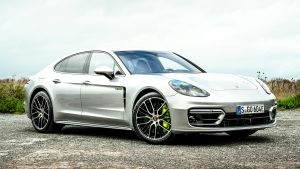
image
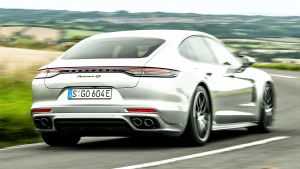
image
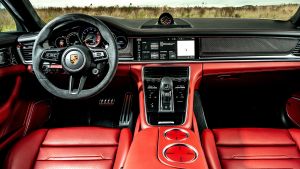
image
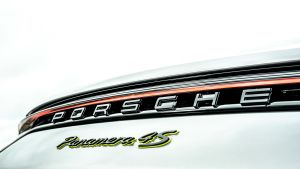
image
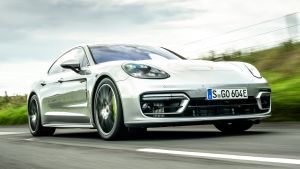
image
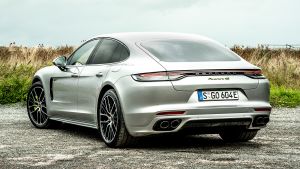
image

image
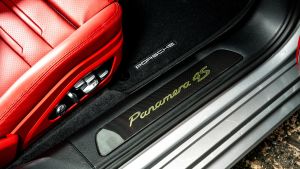
image

image

image

image
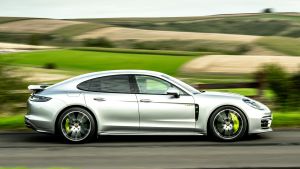
image

image

image
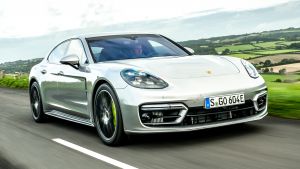
image

image
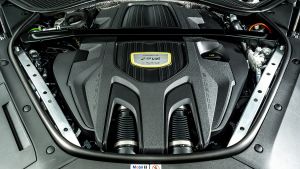
image
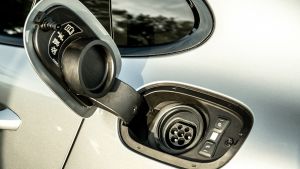
image
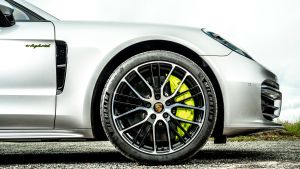
image
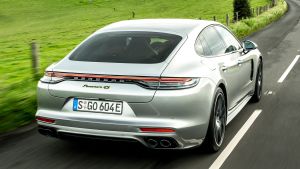
image
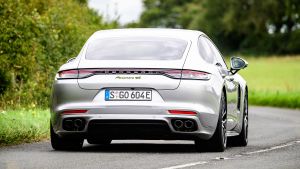
image
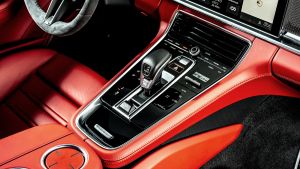
image
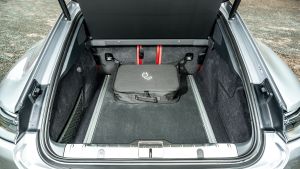
image
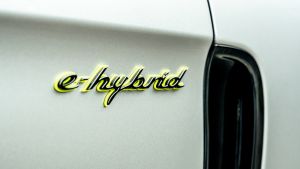
image
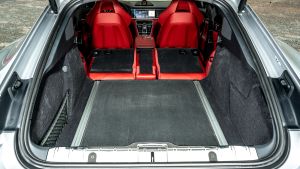
image
On the basis of our drive, conducted on a mix of B-roads, A-roads, dual carriageway and in slow-moving town traffic, that figure is entirely plausible. The Panamera pulls away smoothly in electric mode, with only a faint whine if you stamp on the right-hand pedal. Do that and in most situations the V6 motor will cut in, accompanied by a leaping needle on the rev-counter and a very mild judder. Given the car’s outputs, it is commendably swift and polite in its transition.
Of course, you can force the Panamera to run on electricity alone – and at speeds of up to 87mph. But we left our car in Hybrid mode, allowing the system to decide when it was most appropriate to let the batteries take the strain. The trip computer’s fuel economy display is limited to 99mpg, but it’s safe to say that over the aforementioned blend of roads, the car managed north of 100mpg and still had a few miles of EV range left after the 35-mile mark.
Where the 4S E-Hybrid struggles a little is on living up to Porsche’s famous dynamics. It feels lighter over the nose than a V8 Panamera, but it can’t quite disguise its overall bulk, which is almost 200kg more than a conventionally powered variant, at more than 2,200kg. Body control remains strong, while the steering is satisfyingly weighty and pleasingly direct.
But there are extra thunks and thuds as the Panamera’s suspension meets its match on the UK’s road surfaces. These noises are likely to be joined by impacts on cat’s eyes on all but the widest roads, for the Panamera in general remains a car that can feel just that little bit too big for Britain’s creaking network.

image

image

image

image

image

image

image

image

image

image

image

image

image

image

image

image

image

image

image

image

image

image

image

image

image
The noise is a bit of a letdown, too; there’s a sonorous V6 in there somewhere, but it makes only fleeting appearances; the rest of the time it sounds almost appliance-like, just a relatively distant drone with a metallic edge. Anyone expecting a V6 howl is likely to be a little disappointed.
The Panamera’s cabin escapes the facelift pretty much unscathed – with exception of wireless Apple CarPlay. The basic layout is still sound, though, with beautiful materials in the right places, a 12-inch widescreen infotainment system and digital instruments that do a lovely job of displaying useful information at just the right time – a more detailed map of an upcoming junction in navigation instructions, for example.
There’s room in the back for two adults, but the Panamera does lose some boot capacity because of the hybrid installation; it’s around 60 litres down on a regular Panamera’s load bay, at 403 litres, although you can lower the rear seats to expand that to 1,242 litres. And of course the 4S E-Hybrid is also available in the Sport Turismo estate bodystyle if you’re after greater practicality.
Continue reading...
The hybrid Porsche Panamera is genuinely capable of 30 miles on pure-electric power, but it’s also a car that can’t quite match the awe-inspiring charm of its stablemates. The 4S E-Hybrid is the smartest car in the new line-up, but we’re less convinced that it’s the best Panamera outright.
Until recently, the Panamera was the flagship saloon in the Porsche range. But the arrival of the all-electric Taycan has shifted the landscape somewhat, so the Panamera has been treated to some timely updates and more potent powertrains.
At the top of it all sits a revised Turbo S, now producing a frankly ludicrous 621bhp and 820Nm of torque. But for our first taste of the revised Panamera, we’re sampling a new addition to the range, and one that reflects the ever-increasing importance of electrified powertrains in the line-up.
- SEE MORE Best fast family cars 2020
This 4S E-Hybrid is, at present, the only plug-in hybrid Panamera you can buy, although you can bet that a more modest version and some sort of ultra-rapid Turbo S hybrid are also in the pipeline.
Mind you, the 4S E-Hybrid isn’t a bad starting point. It mixes a 134bhp electric motor with a 435bhp 2.9-litre twin-turbo V6 petrol engine, and the total system output is 552bhp and 750Nm, delivering a 0-62mph sprint in 3.7 seconds and a top speed of 180mph. Those hard numbers look relatively modest compared with the Turbo S’s, but this E-Hybrid gets a bigger battery than before (up from 14.1kWh to 17.9kWh) so it can travel around 33 miles on electricity alone.

image

image

image

image

image

image

image

image

image

image

image

image

image

image

image

image

image

image

image

image

image

image

image

image

image
On the basis of our drive, conducted on a mix of B-roads, A-roads, dual carriageway and in slow-moving town traffic, that figure is entirely plausible. The Panamera pulls away smoothly in electric mode, with only a faint whine if you stamp on the right-hand pedal. Do that and in most situations the V6 motor will cut in, accompanied by a leaping needle on the rev-counter and a very mild judder. Given the car’s outputs, it is commendably swift and polite in its transition.
Of course, you can force the Panamera to run on electricity alone – and at speeds of up to 87mph. But we left our car in Hybrid mode, allowing the system to decide when it was most appropriate to let the batteries take the strain. The trip computer’s fuel economy display is limited to 99mpg, but it’s safe to say that over the aforementioned blend of roads, the car managed north of 100mpg and still had a few miles of EV range left after the 35-mile mark.
Where the 4S E-Hybrid struggles a little is on living up to Porsche’s famous dynamics. It feels lighter over the nose than a V8 Panamera, but it can’t quite disguise its overall bulk, which is almost 200kg more than a conventionally powered variant, at more than 2,200kg. Body control remains strong, while the steering is satisfyingly weighty and pleasingly direct.
But there are extra thunks and thuds as the Panamera’s suspension meets its match on the UK’s road surfaces. These noises are likely to be joined by impacts on cat’s eyes on all but the widest roads, for the Panamera in general remains a car that can feel just that little bit too big for Britain’s creaking network.

image

image

image

image

image

image

image

image

image

image

image

image

image

image

image

image

image

image

image

image

image

image

image

image

image
The noise is a bit of a letdown, too; there’s a sonorous V6 in there somewhere, but it makes only fleeting appearances; the rest of the time it sounds almost appliance-like, just a relatively distant drone with a metallic edge. Anyone expecting a V6 howl is likely to be a little disappointed.
The Panamera’s cabin escapes the facelift pretty much unscathed – with exception of wireless Apple CarPlay. The basic layout is still sound, though, with beautiful materials in the right places, a 12-inch widescreen infotainment system and digital instruments that do a lovely job of displaying useful information at just the right time – a more detailed map of an upcoming junction in navigation instructions, for example.
There’s room in the back for two adults, but the Panamera does lose some boot capacity because of the hybrid installation; it’s around 60 litres down on a regular Panamera’s load bay, at 403 litres, although you can lower the rear seats to expand that to 1,242 litres. And of course the 4S E-Hybrid is also available in the Sport Turismo estate bodystyle if you’re after greater practicality.
| Model: | Porsche Panamera 4S E-Hybrid |
| Price: | £101,690 |
| Engine: | 2.9-litre V6 petrol/electric motor |
| Power/torque: | 552bhp/750Nm |
| Transmission: | Eight-speed dual-clutch auto, four-wheel drive |
| 0-62mph: | 3.7 seconds |
| Top speed: | 180mph |
| Economy: | 100.9-128.4mpg |
| CO2: | 51-64g/km |
| On sale: | Now |
Continue reading...
